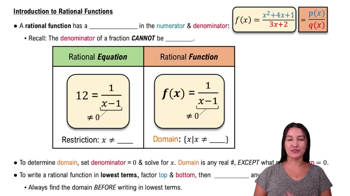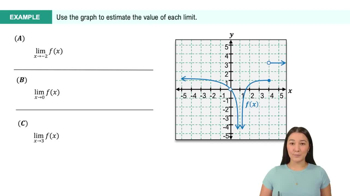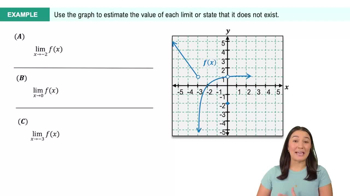Table of contents
- 0. Functions7h 52m
- Introduction to Functions16m
- Piecewise Functions10m
- Properties of Functions9m
- Common Functions1h 8m
- Transformations5m
- Combining Functions27m
- Exponent rules32m
- Exponential Functions28m
- Logarithmic Functions24m
- Properties of Logarithms34m
- Exponential & Logarithmic Equations35m
- Introduction to Trigonometric Functions38m
- Graphs of Trigonometric Functions44m
- Trigonometric Identities47m
- Inverse Trigonometric Functions48m
- 1. Limits and Continuity2h 2m
- 2. Intro to Derivatives1h 33m
- 3. Techniques of Differentiation3h 18m
- 4. Applications of Derivatives2h 38m
- 5. Graphical Applications of Derivatives6h 2m
- 6. Derivatives of Inverse, Exponential, & Logarithmic Functions2h 37m
- 7. Antiderivatives & Indefinite Integrals1h 26m
- 8. Definite Integrals4h 44m
- 9. Graphical Applications of Integrals2h 27m
- 10. Physics Applications of Integrals 2h 22m
1. Limits and Continuity
Introduction to Limits
Problem 2.7.47
Textbook Question
Use the precise definition of infinite limits to prove the following limits.
 Verified step by step guidance
Verified step by step guidance1
Step 1: Understand the definition of an infinite limit. The limit of a function f(x) as x approaches a value c is infinity if for every positive number M, there exists a δ > 0 such that if 0 < |x - c| < δ, then f(x) > M.
Step 2: Identify the function and the point of interest. Here, the function is f(x) = \( \frac{1}{x^2} + 1 \) and we are interested in the behavior as x approaches 0.
Step 3: Set up the inequality based on the definition. We need to show that for every M > 0, there exists a δ > 0 such that if 0 < |x| < δ, then \( \frac{1}{x^2} + 1 > M \).
Step 4: Simplify the inequality \( \frac{1}{x^2} + 1 > M \) to \( \frac{1}{x^2} > M - 1 \). This implies \( x^2 < \frac{1}{M - 1} \) and thus |x| < \( \frac{1}{\sqrt{M - 1}} \).
Step 5: Choose δ = \( \frac{1}{\sqrt{M - 1}} \). This choice of δ ensures that whenever 0 < |x| < δ, the inequality \( \frac{1}{x^2} + 1 > M \) holds, proving the limit is infinity.
 Verified video answer for a similar problem:
Verified video answer for a similar problem:This video solution was recommended by our tutors as helpful for the problem above
Video duration:
6mPlay a video:
Was this helpful?
Key Concepts
Here are the essential concepts you must grasp in order to answer the question correctly.
Infinite Limits
Infinite limits occur when the value of a function increases without bound as the input approaches a certain point. In this context, we analyze the behavior of the function as x approaches 0. If the function's value grows larger and larger, we denote this behavior as approaching infinity, which is a key aspect of understanding limits in calculus.
Recommended video:

One-Sided Limits
Limit Definition
The precise definition of a limit involves the concept of epsilon (ε) and delta (δ). For a limit to equal L as x approaches a value c, for every ε > 0, there exists a δ > 0 such that if 0 < |x - c| < δ, then |f(x) - L| < ε. This formal definition helps in rigorously proving the behavior of functions near specific points, especially when dealing with infinite limits.
Recommended video:

Definition of the Definite Integral
Behavior of Rational Functions
Rational functions are ratios of polynomials, and their behavior near certain points can lead to infinite limits. In the given limit, as x approaches 0, the term 1/x² dominates the expression, leading to an increase towards infinity. Understanding how the numerator and denominator interact as x approaches critical values is essential for analyzing limits effectively.
Recommended video:

Intro to Rational Functions

 6:47m
6:47mWatch next
Master Finding Limits Numerically and Graphically with a bite sized video explanation from Callie
Start learning




